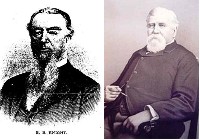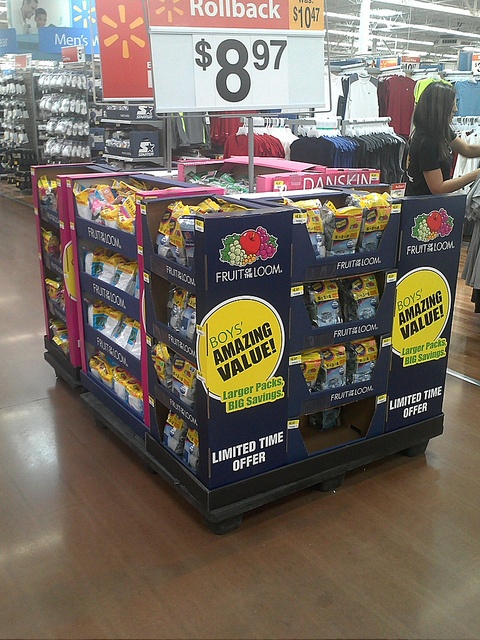Fruit of the Loom, a household name synonymous with comfort and value, boasts a rich history dating back to 1851. Founded by the Knight brothers, Benjamin and Robert, in Rhode Island, the company’s story began modestly. They acquired the Pontiac Mills in Warwick, Rhode Island, and established the “B.B. and R. Knight Corporation,” focusing on the production of high-quality textiles. This entrepreneurial spirit, coupled with a dedication to crafting well-made fabrics, laid the foundation for over 170 years of success, making Fruit of the Loom a staple in closets around the world.

Innovation and a keen eye for customer preferences have been hallmarks of the Fruit of the Loom journey. In 1856, the company introduced the now-iconic brand name “Fruit of the Loom.” The inspiration for the name is believed to have come from Robert Knight’s friend, Rufus Skeel. Skeel’s daughter, impressed by the quality of the company’s muslin fabric, playfully decorated bolts of cloth with images of apples, her family’s favorite fruit. These “fruity” bolts proved to be the most popular, prompting Knight to see the potential in a name that referenced the bounty and quality his textiles offered. He adopted the evocative phrase “Fruit of the Loom,” a clever play on the biblical expression “fruit of the womb,” signifying the creation of something valuable and essential. Just one year after the first federal trademark laws were passed in the United States, Knight secured trademark number 418 for the brand in 1871, solidifying Fruit of the Loom’s place in American commercial history.
Beyond its name, Fruit of the Loom’s early success can be attributed to its commitment to quality and customer satisfaction. In 1891, the company introduced its “Unconditional Guarantee,” a bold move that promised a full refund to any customer dissatisfied with their product. This unprecedented level of customer focus helped build trust and loyalty, establishing Fruit of the Loom as a reliable brand.
The 20th century ushered in a new era of growth for Fruit of the Loom. The company expanded its product offerings beyond textiles, venturing into the realm of apparel. Their first foray into clothing came with the introduction of muslin underwear in the early 1900s. This move proved to be a turning point, solidifying Fruit of the Loom’s position as a leading provider of everyday essentials. Over the decades, the company continued to innovate, introducing a wider range of undergarments for men, women, and children. Their commitment to affordability and quality ensured that Fruit of the Loom remained a go-to brand for families across the nation.
Fruit of the Loom’s story is not just about underwear. The latter half of the 20th century saw the brand expand into casual wear, offering comfortable and stylish t-shirts, sweatpants, and sweatshirts. This diversification allowed Fruit of the Loom to cater to a broader range of customer needs, solidifying its position as a one-stop shop for comfortable and affordable clothing for the whole family.
Today, Fruit of the Loom remains a global leader in apparel, recognized for its dedication to comfort, value, and quality. From their iconic taglines like “Everybody’s wearing Fruit of the Loom” to their ever-evolving product lines, the brand has successfully adapted to changing consumer preferences while staying true to its core values. With a rich history and a commitment to innovation, Fruit of the Loom continues to be a trusted name in closets around the world.
Target Audience of Fruit of the Loom
Fruit of the Loom caters to a broad audience, with a focus on families and budget-conscious shoppers. Their main target demographic is adults aged 18-54, particularly those who are married and college graduates. This group often prioritizes practicality and value, which aligns perfectly with Fruit of the Loom’s reputation for affordable, comfortable basics like underwear.
However, the brand recognizes the evolving market and is actively trying to reach younger demographics. Their recent “Fruitisms” campaign utilizes popular platforms like TikTok and influencer marketing to showcase their product variety and appeal to a younger generation seeking comfort and affordability in their clothing.
Marketing Strategies of Fruit of the Loom
Fruit of the Loom employs several marketing strategies to promote its products and maintain its market position. Here are some detailed aspects of its marketing strategies:
1. Brand Positioning
Fruit of the Loom positions itself as the go-to brand for comfortable, affordable, and everyday essential clothing. This focus is evident in their mission statement, which emphasizes the positive impact they aim to have on people’s lives through their products. Their core values – positivity, conviction, and continuous improvement – further solidify their commitment to providing reliable and feel-good clothing.
The key element of their brand positioning is the trifecta of comfort, affordability, and style. Their products are designed to be soft, practical, and offer a variety of styles to suit different preferences, all at accessible price points. This resonates with a broad audience, particularly families and budget-conscious shoppers seeking quality basics but not compromising on a touch of trendiness.
Fruit of the Loom leverages humor and relatable characters in their advertising to communicate this positioning effectively. Social media platforms are another tool they utilize to connect with customers and showcase their product offerings. This multi-pronged approach has established Fruit of the Loom as a leading apparel brand globally, with a presence in over 160 countries.
2. Product Range
Fruit of the Loom’s extensive product range serves as a cornerstone of their marketing strategy. By offering a diverse selection that goes beyond their underwear staple, they cater to a wider audience. This breadth of products, encompassing casualwear, sportswear, and accessories, allows them to reach customers with varying needs and preferences, ultimately increasing their market share and sales.
This diversification also plays a crucial role in setting them apart from competitors. While many apparel companies offer similar core items, Fruit of the Loom’s comprehensive range positions them uniquely. Customers seeking a one-stop shop for everyday essentials can find everything from comfortable basics to activewear within the Fruit of the Loom portfolio.
Furthermore, the company strategically expands their product line to stay on top of trends. They understand the dynamic nature of the apparel market and the need to adapt. By continuously introducing new and relevant products, Fruit of the Loom demonstrates its commitment to staying fresh and competitive, ensuring long-term success in the ever-evolving fashion landscape.
3. Distribution Channels
Fruit of the Loom strategically utilizes a multi-pronged distribution approach to maximize product accessibility and brand awareness. The core of their strategy lies in their vertically integrated supply chain. This allows them to manage most aspects of production in-house, from raw materials to finished goods. Their network encompasses distribution centers, sewing and packaging facilities, and even textile mills. This level of control fosters efficiency, cost optimization, and consistent quality throughout the manufacturing process.
They manufacture the majority of their products (82% in 2022) within their own facilities across 11 countries. This network includes distribution centers, sewing and packaging plants, and even textile mills. This in-house control allows them to streamline operations, optimize costs, and maintain consistent quality throughout the production process.
Beyond their direct network, Fruit of the Loom tailors their distribution approach based on the region. In Europe, for instance, they’ve established a strong network of wholesalers and business partners. This network, along with their central European headquarters and distribution center in Kaiserslautern, Germany, ensures efficient product delivery and excellent customer service across over 30 European countries. Similarly, in India, they’ve partnered with Rupa & Company Limited for local distribution and marketing, catering specifically to the Indian market.
This regional adaptation extends to their global manufacturing presence. Fruit of the Loom has production facilities strategically located in various countries, including the United States, El Salvador, Vietnam, and Morocco. This global footprint allows them to produce closer to their target markets, reducing transportation costs and expediting product delivery to a wider customer base.
Beyond their own network, Fruit of the Loom strategically partners with major retailers like Walmart and Target. This collaboration grants them access to a vast customer base and prime shelf space within high-traffic stores, significantly increasing brand visibility and product exposure to potential buyers.

Furthermore, Fruit of the Loom leverages technology to expand their reach. They utilize a cloud-based solution called SPS Fulfillment, which connects them to a broader network of retailers. This system streamlines communication and distribution processes, allowing Fruit of the Loom to efficiently deliver products to a wider range of stores. This multi-layered distribution strategy ensures Fruit of the Loom products are conveniently available to a large audience across various retail channels.
4. Promotional Activities
ruit of the Loom employs a diverse range of promotional activities to reach their target audience and build brand awareness. The core of their strategy lies in utilizing a multi-channel approach, encompassing traditional and digital media.
They leverage TV commercials, billboards, and social media campaigns to spread their message. For instance, their “#starthappy” campaign highlights the positive impact of comfortable undergarments and utilizes TV, billboards, and Twitter to reach a broad audience.

Furthermore, Fruit of the Loom recognizes the importance of digital marketing to connect with younger demographics. Their “Fruitisms” campaign utilizes short-form videos specifically tailored for digital and social media platforms like connected TV, online video, and paid social media. They’ve also partnered with popular streaming platforms like Vevo and social media apps like Snapchat to generate significant brand exposure. Their collaboration with Vevo to premiere music videos by popular artists garnered them a staggering four billion social impressions. Similarly, their Snapchat campaign featuring interactive AR experiences creates a fun and engaging way to connect with younger audiences. By implementing these diverse promotional activities, Fruit of the Loom effectively reaches a wider audience and strengthens brand recognition across generations.

5. Product Quality and Innovation
Fruit of the Loom prioritizes product quality and innovation as a key marketing strategy. They understand the need to constantly improve and adapt to stay relevant. This commitment is evident in their focus on introducing new and convenient services. For instance, they’ve implemented direct-to-consumer programs like auto-delivery and subscription boxes (Fresh Picks) to cater to evolving customer preferences. Additionally, their partnership with CPGvision demonstrates their dedication to optimizing their trade promotion strategies, ensuring efficient product delivery to retailers.
Furthermore, Fruit of the Loom recognizes the growing importance of sustainability. They’ve revamped their classic products to be more eco-friendly by incorporating breathable, sustainable fabrics. This focus on environmental responsibility resonates with a growing segment of their target audience and positions them as a brand that prioritizes ethical practices.
By continuously innovating and prioritizing quality alongside affordability and style, Fruit of the Loom positions itself as a reliable brand that adapts to meet the ever-changing needs of its customers. This commitment to improvement strengthens their brand image and fosters customer loyalty.
6. Advertising
Fruit of the Loom utilizes a multi-pronged advertising strategy to target a younger demographic and establish a brand refresh. The core of this strategy centers around reaching younger consumers through various channels, both traditional and digital.
Their recent campaigns exemplify this approach. The “Fruitisms” campaign showcases the brand’s diverse product range across various lifestyles, specifically targeting younger millennials and Gen Z. This message is disseminated through a multi-channel approach, encompassing TV commercials, paid social media advertisements, and even their newly launched TikTok channel. Similarly, the “Start Happy” campaign utilizes a combination of TV, billboards, and social media with the hashtag #starthappy, creating a relatable message about comfortable underwear and a positive start to the day.
Recognizing the influence social media holds with younger audiences, Fruit of the Loom has actively incorporated influencer marketing into their strategy. Partnering with popular social media personalities allows them to leverage a trusted source of recommendations, potentially swaying younger shoppers towards their products.
This digital focus is further emphasized by their website revamp designed to be more user-friendly and mobile-friendly, catering to the browsing habits of their target demographic. They’ve also increased their social media activity, creating content specifically relevant to younger audiences. By implementing these diverse advertising strategies, Fruit of the Loom strives to effectively reach and resonate with a younger generation of potential customers.
Overall, Fruit of the Loom’s marketing strategies focus on delivering value, quality, and accessibility to its target audience while remaining adaptable to changes in the competitive landscape and consumer behavior.
Marketing Mix of Fruit of the Loom
Fruit of the Loom (FOL) has carved a niche in the undergarment industry with comfortable, basic apparel at affordable prices. Let’s delve into the 4Ps of their marketing mix and see how they strategically position themselves:
1. Product
Variety: FOL offers a wide range of basic and value-priced undergarments for men, women, and kids. This includes T-shirts, underwear, socks, bras, and loungewear. While they don’t boast a ton of variety in terms of style, they excel in providing core essentials in various cuts (crew neck, V-neck, briefs, boxers) and sizes.
Quality: FOL prioritizes comfort and affordability. Their products are known for being well-made with good stitching and soft fabrics, ideal for everyday wear.
Innovation: While not a core focus, FOL occasionally ventures into new product lines like moisture-wicking fabrics or breathable mesh designs to cater to specific needs.
Brand Extensions: FOL has leveraged its brand recognition by extending into loungewear and casual apparel, offering comfortable basics like sweatpants and T-shirts.
2. Price
Value-Driven: FOL’s primary strategy is affordability. They target budget-conscious consumers seeking comfortable basics without a hefty price tag. This is evident in their frequent sales and multi-pack offerings.
Competitive Pricing: FOL closely monitors competitor pricing, particularly store brands and private labels, to ensure they remain the go-to option for price-sensitive consumers.
Price Skimming (Limited): FOL might occasionally introduce new, innovative products at a slightly higher price point to test the market and position themselves as offering more than just basic essentials.
3. Place
Mass Distribution: FOL prioritizes accessibility. Their products are widely available in supermarkets, discount stores, department stores, and online retailers. This ensures maximum reach to their target audience.
Geographic Focus: FOL primarily focuses on the North American market, with a strong presence in the United States and Canada. However, they may have limited distribution in other countries through international retailers.
Inventory Management: FOL works closely with retailers to maintain consistent stock levels and avoid stockouts, especially during peak seasons like back-to-school or holidays.
4. Promotion
Mass Media Advertising (Limited): FOL utilizes mass media advertising sparingly, relying more on targeted promotions and in-store displays.
Promotional Strategies: FOL heavily relies on promotions and discounts to attract price-conscious consumers. This includes coupons, sales, and multi-pack bundles.
Public Relations: FOL occasionally engages in public relations efforts to promote their brand image. This might involve sponsorships, charitable partnerships, or influencer marketing.
Digital Marketing: FOL is increasingly leveraging digital marketing channels like social media to connect with their target audience. This allows for targeted advertising and brand storytelling.
By carefully considering these details and adapting their 4P mix, Fruit of the Loom can maintain its position as a leader in the value-driven undergarment market while exploring opportunities for growth and brand expansion.
Also Read: The Berkshire Hathaway Story: How Warren Buffett Built a Financial Empire
To read more content like this, subscribe to our newsletter



